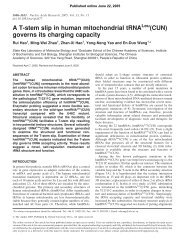somites. The defects include disrupted somite boundaries and irregular somite size (79%, N=100, Fig. 1D). The malformation of somites in Mespo MO-injected embryos is shown more clearly on frontal sections stained with 12/101 or with DAPI staining of nuclei. Compared with the uninjected side, somites in Mespo MO-injected side are poorly defined, with no metameric shape typical for this tissue. Also, somite nuclei are abnormally aligned, indicating that the patterning of somite is severely disrupted (67%, N=30, Figs. 1F, H). As a control, the somite morphology in control MO-injected embryos remains identical to that in the uninjected side, with regularly arranged allied cells (Figs. 1E, G). Aiming to verify that the phenotype described above is due to specific depletion of Mespo, we carried out rescue experiments. We prepared a mutated Mespo (mMespo) cDNA, which codes for the same polypeptide as the Mespo protein but differs from Mespo cDNA by seven bases. Injection of the resulting pCS– mMespo plasmid effectively rescues the phenotypic defects caused by Mespo MO in 85% (N=100) of the injected embryos (Supplemental Fig. 1). We also injected Mespo MO into DMZ of four-cell-stage embryos, where Mespo is not expressed, and found no effect on embryo development (data not shown). These results indicate that the effect of Mespo MO is specific. Taken together, our results indicate that depletion of Mespo caused the morphological defects of somite patterning. Depleting Mespo disrupts expression of genes in the PSM The results described above indicate that lacking of Mespo in embryos causes segmentation defects. In Xenopus, several molecules have been demonstrated to play roles in segmentation process, including PAPC (Kim et al., 2000), Thylacine1 (Thy) (Sparrow et al., 1998) and XDelta-1 (Pourquie, 2003). To evaluate whether depleting Mespo interferes the expression of segmental marker genes, we examined the expression of genes such as PAPC, Thy and XDelta-1 in embryos injected with Mespo MO. Compared with the uninjected side, the expression of PAPC is lost in Mespo MO-injected side (85%, N=78, Fig. 2B). The loss of PAPC expression in embryos injected with Mespo MO is specific since it could be rescued by coinjecting with pCS–mMespo (70%, N=60, Fig. 2C). The segmental expression of Thy in somitomeres is severely disrupted (87%, N=65, Fig. 2E), and it was observed that the somitomeric expression pattern of XDelta-1 is also perturbed (80%, N=81, Fig. 2G). As a control, injection of a mixture of pCS–LacZ and control MO resulted in no difference in the expression level and pattern of PAPC, Thy or XDelta-1 in both injected and uninjected sides (Figs. 2A, D, F). These results indicate that depletion of Mespo profoundly changes the expression of PAPC, Thy and XDelta-1 in the PSM, suggesting that Mespo acts in the PSM to control segmental patterning. Since XDelta-1 is a component of the Notch/Delta pathway, these results suggest that Mespo controls segmental patterning by regulating Notch/Delta signaling (Pourquie, 2003). To gain further insight into the cause of somite defects in embryos lacking Mespo function, we examined the expression of XBra that plays major roles in development of paraxial J. Wang et al. / Developmental Biology 304 (<strong>2007</strong>) 836–847 mesoderm (Conlon and Smith, 1999). We found that in embryos depleted for Mespo, the expression of XBra is increased in the Mespo MO-injected side (67%, N=90, Fig. 2I), as compared to the control side, indicating that XBra expression is negatively regulated by Mespo, a phenomenon also observed in Mespo null mutant mouse (Yoon and Wold, 2000). XBra expression is not changed in control MO-injected embryos (Fig. 2H). Interestingly, in embryos injected with Mespo MO, Mespo mRNA is expressed at levels higher than the control side (78%, N=78, Fig. 2K). Expression of Mespo is not changed in the control MO-injected embryos (Fig. 2J). This result implies that Mespo has a negative regulatory effect on its own mRNA expression in the PSM. Taken together, we provide evidence here that Mespo is responsible not only for segmental specific gene expression, but is also involved in regulating Xbra and Mespo expression. Thus we conclude that Mespo is essential for somitogenesis. Wnt/β-catenin signaling in the PSM Observations from studies on mouse embryos have demonstrated that Wnt/β-catenin signaling is involved in somitogenesis (Aulehla et al., 2003). Regional similarity between expression patterns of Wnts and Mespo in mouse embryos, as well as the phenotypic similarities of Wnt and Mespo null mutant mouse (Takada et al., 1994; Yoon and Wold, 2000), raises a possibility that Wnt signaling regulates Mespo expression in somitogenesis. However, the existence of Wnt signaling in Xenopus PSM has not been documented. We performed whole-mount in situ hybridization to analyze Wnt gene expression in the PSM. Like in other vertebrates, Xenopus PSM is subdivided into two distinct regions featured by expression pattern of the bHLH family genes (Fig. 3K) (Kim et al., 2000; Pourquie, 2003). In the caudal domain of the PSM, Mespo is expressed in the entire region referred as the tailbud domain (TBD) (Figs. 3I, J). Thy transcripts are restricted in the rostral region of the PSM and localized to the anterior half of somitomeres (Figs. 3G, H, I, J). At the neurula stage, XWnt8 is expressed at high level in the TBD (Figs. 3A, B, E, F, G, H), whereas Wnt antagonist Dkk1 is uniformly expressed in somitomeres (Figs. 3C, D, E, F). The expression patterns of these genes indicate that Wnt signals exist in the TBD and support that Wnt/β-catenin signaling is involved in Xenopus somitogenesis. Altering Wnt/β-catenin signaling activity affects expression of Mespo To test whether Wnt/β-catenin signaling regulates Mespo expression, pCS–Lef1–VP16 (a dominant active form of Lef1) DNA was injected into VMZ of one cell of four-cell-stage embryos and Mespo expression was examined at stage 19. Mespo expression in the injected side is increased compared with the control side (75%, N=70, Fig. 4B). When embryos were injected with pCS–β-catenin DNA, Mespo expression is also increased (Supplemental Fig. 2B). In contrast, injection of pCS–Lef1–EnR (a dominant negative form of Lef1) DNA 839
840 J. Wang et al. / Developmental Biology 304 (<strong>2007</strong>) 836–847 Fig. 2. Expression patterns of genes responsible for segmental patterning are altered in embryos lacking Mespo function. For all embryos, anterior is to the left. (A–K) One VMZ cell of four-cell-stage embryos injected with control MO (A, D, F, H and J), or Mespo MO (B, E, G, I and K) or Mespo MO plus 35 pg pCS–mMespo (C) and the embryos were fixed at neurula stage for in situ hybridization to detect the PSM marker gene expression: (A–C) PAPC, (D, E) Thy, (F,G)XDelta-1, (H, I) XBra, (J, K) Mespo. Bracket in panels B and E indicates the disruption of segmental expression of PAPC and Thy, respectively. Bracket in panel C indicates the rescue of PAPC expression by coinjecting Mespo MO with pCS–mMespo. Arrowhead in panel G indicates the disruption of segmental expression of XDelta-1. Arrowhead in panel I indicates the increase of XBra expression. Arrowhead in panel K indicates the increase of Mespo expression. results in the opposite effect where Mespo expression is markedly reduced (56%, N=65, Fig. 4C). We also observed that Mespo expression is decreased at stage 10 when injecting embryos with lef1–EnR mRNA at four-cell stage (Supplemental Fig. 2D). These changes are tightly associated with the changing of Wnt/β-catenin signaling activity, because the







